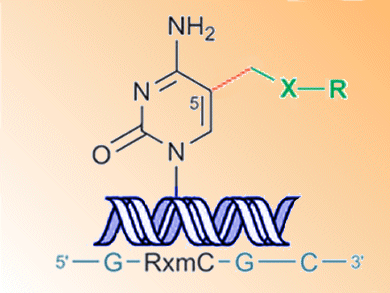5-Hydroxymethylcytosine (hmC) is a base that was recently discovered to be present in mammalian DNA. These hmC residues may play an independent role in yet unknown epigenetic pathways, thus their detection by new and efficient analytical techniques is important.
A research group based at Vilnius University, Lithuanian, report that DNA cytosine methyltransferaseses can catalyze the nucleophilic substitution of the hydroxy group in hmC with thiols and selenols. This reaction was used to introduce fluorescence labeling with fluorescein by treatment with an N-hydroxysuccinimide ester, thus being pivotal in the facile detection of hmC.
Klimašauskas and co-workers believe the transformations outlined in this study may pave the way for the sequence-specific derivatization and analysis of other modes of epigenetic regulation in mammalian DNA.

Images: (c) Wiley-VCH
- Methyltransferase-Directed Derivatization of 5-Hydroxymethylcytosine in DNA
Z. Liutkevičiūtė, E. Kriukienė, I. Grigaitytė, V. Masevičius, S. Klimašauskas,
Angew. Chem. Int. Ed. 2011.
DOI: 10.1002/anie.201007169 - Z. Liutkevičiūtė, E. Kriukienė, I. Grigaitytė, V. Masevičius, S. Klimašauskas,
Angew. Chem. 2011.
DOI: 10.1002/anie.201007169




